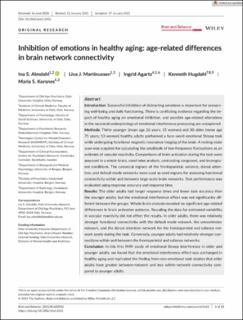| dc.description.abstract | Introduction: Successful inhibition of distracting emotions is important for preserving well-being and daily functioning. There is conflicting evidence regarding the impact of healthy aging on emotional inhibition, and possible age-related alterations in the neuronal underpinnings of emotional interference processing are unexplored.
Methods: Thirty younger (mean age 26 years; 15 women) and 30 older (mean age 71 years; 13 women) healthy adults performed a face–word emotional Stroop task while undergoing functional magnetic resonance imaging of the brain. A resting-state scan was acquired for calculating the amplitude of low-frequency fluctuations as an estimate of vascular reactivity. Comparisons of brain activation during the task were assessed in a whole-brain, voxel-wise analysis, contrasting congruent, and incongruent conditions. The canonical regions of the frontoparietal, salience, dorsal attention, and default mode networks were used as seed regions for assessing functional connectivity within and between large-scale brain networks. Task performance was evaluated using response accuracy and response time.
Results: The older adults had longer response times and lower task accuracy than the younger adults, but the emotional interference effect was not significantly different between the groups. Whole-brain analysis revealed no significant age-related differences in brain activation patterns. Rescaling the data for estimated variability in vascular reactivity did not affect the results. In older adults, there was relatively stronger functional connectivity with the default mode network, the sensorimotor network, and the dorsal attention network for the frontoparietal and salience network seeds during the task. Conversely, younger adults had relatively stronger connections within and between the frontoparietal and salience networks.
Conclusion: In this first fMRI study of emotional Stroop interference in older and younger adults, we found that the emotional interference effect was unchanged in healthy aging and replicated the finding from non-emotional task studies that older adults have greater between-network and less within-network connectivity compared to younger adults. | en_US |

